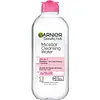What's inside
What's inside
 Key Ingredients
Key Ingredients

No key ingredients
 Benefits
Benefits

 Concerns
Concerns

No concerns
 Ingredients Side-by-side
Ingredients Side-by-side

Water
Skin ConditioningCaprylic/Capric Triglyceride
MaskingC15-19 Alkane
SolventGlycerin
HumectantPolysorbate 20
EmulsifyingPrunus Armeniaca Kernel Oil
MaskingHelianthus Annuus Seed Oil
EmollientAvena Sativa Kernel Extract
AbrasiveRicinus Communis Seed Oil
MaskingCitrus Aurantium Bergamia Fruit Oil
MaskingSantalum Album Oil
MaskingCamellia Oleifera Seed Oil
Skin ConditioningCitrus Paradisi Peel Oil
MaskingCucumis Sativus Seed Extract
Skin ConditioningRosmarinus Officinalis Leaf Extract
AntimicrobialVanilla Planifolia Fruit
MaskingHydrolyzed Cottonseed Protein
Skin ConditioningJuniperus Virginiana Oil
MaskingCinnamomum Camphora Bark Oil
MaskingMyroxylon Pereirae Oil
MaskingTagetes Minuta Flower Oil
MaskingThuja Occidentalis Leaf Oil
MaskingEvernia Prunastri Extract
PerfumingTocopheryl Acetate
AntioxidantHexylene Glycol
EmulsifyingAcrylates/C10-30 Alkyl Acrylate Crosspolymer
Emulsion StabilisingXylitylglucoside
HumectantSodium Astrocaryum Murumuruate
EmollientCapryloyl Glycine
CleansingPentylene Glycol
Skin ConditioningCaprylyl Glycol
EmollientSaccharide Isomerate
HumectantEthylhexylglycerin
Skin ConditioningPEG-60 Hydrogenated Castor Oil
EmulsifyingPotassium Cetyl Phosphate
EmulsifyingTetrasodium Glutamate Diacetate
Sodium Hydroxide
BufferingCitric Acid
BufferingMagnesium Aluminum Silicate
AbsorbentDisodium EDTA
Sodium Citrate
BufferingCistus Ladaniferus Resin
MaskingStyrax Benzoin Resin Extract
MaskingOctadecyl Di-T-Butyl-4-Hydroxyhydrocinnamate
AntioxidantPhenoxyethanol
PreservativePotassium Sorbate
PreservativeSodium Benzoate
MaskingLinalool
PerfumingLimonene
PerfumingBenzyl Benzoate
AntimicrobialWater, Caprylic/Capric Triglyceride, C15-19 Alkane, Glycerin, Polysorbate 20, Prunus Armeniaca Kernel Oil, Helianthus Annuus Seed Oil, Avena Sativa Kernel Extract, Ricinus Communis Seed Oil, Citrus Aurantium Bergamia Fruit Oil, Santalum Album Oil, Camellia Oleifera Seed Oil, Citrus Paradisi Peel Oil, Cucumis Sativus Seed Extract, Rosmarinus Officinalis Leaf Extract, Vanilla Planifolia Fruit, Hydrolyzed Cottonseed Protein, Juniperus Virginiana Oil, Cinnamomum Camphora Bark Oil, Myroxylon Pereirae Oil, Tagetes Minuta Flower Oil, Thuja Occidentalis Leaf Oil, Evernia Prunastri Extract, Tocopheryl Acetate, Hexylene Glycol, Acrylates/C10-30 Alkyl Acrylate Crosspolymer, Xylitylglucoside, Sodium Astrocaryum Murumuruate, Capryloyl Glycine, Pentylene Glycol, Caprylyl Glycol, Saccharide Isomerate, Ethylhexylglycerin, PEG-60 Hydrogenated Castor Oil, Potassium Cetyl Phosphate, Tetrasodium Glutamate Diacetate, Sodium Hydroxide, Citric Acid, Magnesium Aluminum Silicate, Disodium EDTA, Sodium Citrate, Cistus Ladaniferus Resin, Styrax Benzoin Resin Extract, Octadecyl Di-T-Butyl-4-Hydroxyhydrocinnamate, Phenoxyethanol, Potassium Sorbate, Sodium Benzoate, Linalool, Limonene, Benzyl Benzoate
 Reviews
Reviews

Ingredients Explained
These ingredients are found in both products.
Ingredients higher up in an ingredient list are typically present in a larger amount.
Disodium EDTA plays a role in making products more stable by aiding other preservatives.
It is a chelating agent, meaning it neutralizes metal ions that may be found in a product.
Disodium EDTA is a salt of edetic acid and is found to be safe in cosmetic ingredients.
Learn more about Disodium EDTAGlycerin is already naturally found in your skin. It helps moisturize and protect your skin.
A study from 2016 found glycerin to be more effective as a humectant than AHAs and hyaluronic acid.
As a humectant, it helps the skin stay hydrated by pulling moisture to your skin. The low molecular weight of glycerin allows it to pull moisture into the deeper layers of your skin.
Hydrated skin improves your skin barrier; Your skin barrier helps protect against irritants and bacteria.
Glycerin has also been found to have antimicrobial and antiviral properties. Due to these properties, glycerin is often used in wound and burn treatments.
In cosmetics, glycerin is usually derived from plants such as soybean or palm. However, it can also be sourced from animals, such as tallow or animal fat.
This ingredient is organic, colorless, odorless, and non-toxic.
Glycerin is the name for this ingredient in American English. British English uses Glycerol/Glycerine.
Learn more about GlycerinHexylene Glycol is a surfactant. Glycols are a class of alcohols. Hexylene Glycol is a surfactant and emulsifier.
As a surfactant, Hexylene Glycol helps gather dirt and oil on your skin to be washed away.
As an emulsifier, Hexylene Glycol helps keep water and oil together. This prevents them from separating in a product. Hexylene Glycol also thins out the texture of a product by lessening viscosity.
Hexylene Glycol has a small molecular weight.
Learn more about Hexylene GlycolWater. It's the most common cosmetic ingredient of all. You'll usually see it at the top of ingredient lists, meaning that it makes up the largest part of the product.
So why is it so popular? Water most often acts as a solvent - this means that it helps dissolve other ingredients into the formulation.
You'll also recognize water as that liquid we all need to stay alive. If you see this, drink a glass of water. Stay hydrated!
Learn more about Water